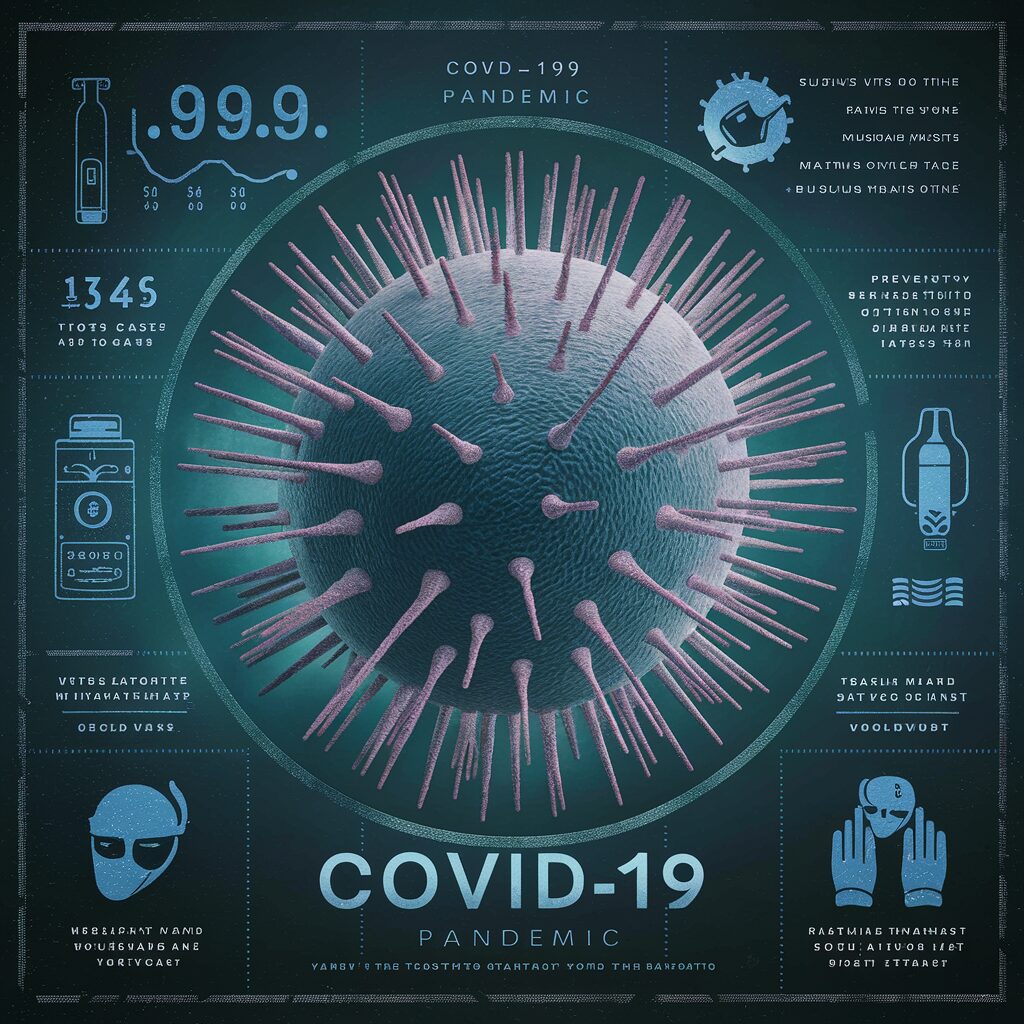Contents
- 1 COVID-19 in 2024: Navigating a Shifting Landscape
- 1.1 Introduction
- 1.2 JN.1: The New Face of COVID-19 (March 2024)
- 1.3 read more posts
- 1.4 The Ever-Evolving Threat: Why Variant Monitoring Matters
- 1.5 read more posts
- 1.6 Navigating the Vaccination Landscape in 2024
- 1.7 read more posts
- 1.8 Roadblocks on the Path to Progress: Challenges in Overcoming COVID-19
- 1.9 read more posts
- 1.10 A Multifaceted Approach: Experts Weigh In on Managing COVID-19
- 1.11 read more posts
- 1.12 Conclusion
- 1.13 read more posts
- 1.14 FAQs
- 1.15 read more posts
Read DISCLAIMER
Navigating COVID-19 in 2024: Understand new variants like JN.1, explore vaccination strategies, and discover how to stay safe and informed in an ever-evolving landscape.
Introduction
Two years into a world forever changed by COVID-19, the virus remains a force to be reckoned with. While vaccines have brought significant progress, understanding the current landscape of variants and effective vaccination strategies is crucial for staying informed and protected.
JN.1: The New Face of COVID-19 (March 2024)
The landscape of COVID-19 variants continues to shift, and as of March 2024, JN.1, a subvariant of Omicron, has emerged as the dominant player on the global stage. Let’s delve deeper into what this means:

• JN.1: A Subvariant of Omicron:
JN.1 isn’t a completely new virus, but rather a mutated descendant of the previously dominant Omicron variant. This means it shares some characteristics with Omicron, but also possesses unique mutations.
• Increased Transmissibility:
A hallmark of JN.1 is its ability to spread more easily from person to person compared to other circulating variants. This could potentially lead to a rise in new infections, especially among those who are unvaccinated or whose immunity from previous vaccination or infection has waned.
• Partial Immune Evasion:
JN.1’s mutations allow it to partially bypass the immune protection offered by prior COVID-19 exposure, either through vaccination or natural infection. This doesn’t mean vaccines are ineffective, but it highlights the importance of staying up-to-date with recommended booster shots.
• Vaccination Remains Key:
Despite JN.1’s partial immune evasion, getting vaccinated and boosted remains the most effective way to prevent serious illness, hospitalization, and death from COVID-19. Vaccines offer significant protection against severe outcomes, even with JN.1’s emergence.
In essence, JN.1 presents a cause for continued vigilance but not panic. By understanding its properties and staying up-to-date with vaccination recommendations, we can effectively manage this new variant and minimize its impact.
read more posts
The Ever-Evolving Threat: Why Variant Monitoring Matters
The SARS-CoV-2 virus, like many viruses, is a master of change. It constantly mutates, creating new variants with slightly different genetic makeup. While most mutations are inconsequential, some can significantly alter the virus’s behavior. Here’s why monitoring these variants is crucial:
• Continuous Evolution:
This section emphasizes that mutation is an ongoing process, not a one-time event. New variants are constantly emerging, and staying vigilant is key.

• Impact on Transmission and Severity:
Mutations can affect how easily the virus spreads (transmissibility) and how severe the illness it causes can be. Monitoring variants helps us understand if they pose a greater threat or if existing measures are still effective.
Now, let’s explore how variant monitoring informs public health strategies:
• Targeted Vaccines and Treatments:
By analyzing the genetic makeup of new variants, scientists can assess if existing vaccines or treatments remain effective. If not, this knowledge paves the way for developing variant-specific vaccines or treatments that can better target the mutated virus.
• Refined Public Health Measures:
Public health measures like masking and social distancing play a significant role in curbing the spread of COVID-19. Monitoring variants helps determine if these measures need to be adjusted or re-emphasized based on a variant’s transmissibility. For instance, a highly transmissible variant might necessitate stricter masking guidelines in public spaces.

• Early Detection, Proactive Response:
Early detection of new variants is vital. The sooner public health agencies are aware of a potentially problematic variant, the sooner they can implement appropriate measures to minimize its impact. This could involve ramping up testing capabilities, implementing travel restrictions, or issuing new public health advisories.
In conclusion, monitoring variants allows us to stay ahead of the curve. By understanding how the virus is evolving, we can adapt our strategies and effectively manage the ongoing COVID-19 challenge.
read more posts
Vaccination remains our most powerful weapon against COVID-19, but with evolving variants, strategies need to adapt. Here’s a breakdown of key vaccination approaches in 2024:
• The Rise of Bivalent Vaccines:
These next-generation vaccines are designed to offer broader protection than earlier versions. They typically target two strains: the original virus and a previously dominant variant. This provides more comprehensive protection against a wider range of circulating variants, including JN.1.
• Staying Up-to-Date with Boosters:
As the virus evolves, so too do vaccination recommendations. Consulting your healthcare provider is crucial to determine if a bivalent booster shot is recommended for you. They can assess your individual risk factors, vaccination history, and current variant landscape to provide personalized guidance.
• Prioritizing the Vulnerable:
Individuals at higher risk of severe illness from COVID-19, such as older adults and those with underlying health conditions, should be prioritized for vaccination. This ensures they receive the most effective protection possible. Strategies might include targeted outreach programs and ensuring vaccine accessibility for these populations.

• Widespread Vaccination for Herd Immunity:
While prioritizing high-risk groups is important, achieving herd immunity remains a key public health goal. This means vaccinating a sufficiently large portion of the population to indirectly protect those who cannot be vaccinated due to medical reasons or age. Widespread vaccination coverage, combined with public health measures like masking and social distancing, creates a protective barrier that minimizes overall transmission and reduces the risk for everyone.
By staying informed about the latest vaccine recommendations and ensuring everyone who can gets vaccinated, we can collectively build a strong defense against COVID-19 and its variants. Remember, vaccination is a vital tool in protecting yourself, your loved ones, and your community.
read more posts
Roadblocks on the Path to Progress: Challenges in Overcoming COVID-19
Despite significant advancements, several hurdles persist in our fight against COVID-19. Addressing these challenges is essential for achieving long-term control of the virus. Here’s a closer look:
• Waning Immunity:
The effectiveness of vaccines weakens over time. Booster shots are necessary to maintain adequate protection, especially for vulnerable populations like older adults and immunocompromised individuals. Ensuring timely access to booster shots for these groups is crucial.
• Unequal Vaccine Access:
A major roadblock is the global disparity in vaccine access. While some countries have achieved high vaccination rates, others struggle with limited vaccine availability. This not only leaves individuals vulnerable but also creates a breeding ground for new variants to emerge. Global cooperation and initiatives to ensure equitable vaccine distribution are essential.
• Misinformation and Vaccine Hesitancy:
Misinformation and vaccine hesitancy pose significant challenges. Combating these requires a multi-pronged approach. Public awareness campaigns that provide accurate, science-based information about vaccines are vital. Additionally, clear communication from trusted healthcare providers can help address concerns and build vaccine confidence in the community.
Overcoming these challenges requires a collective effort. Governments, healthcare institutions, and individuals all have a role to play. By promoting responsible vaccination practices, advocating for equitable access, and combating misinformation, we can create a future where COVID-19 has a minimal impact on our lives.
read more posts
A Multifaceted Approach: Experts Weigh In on Managing COVID-19
• Individual Vigilance:
Everyone has a role to play. This includes following public health recommendations, such as masking in high-risk settings like crowded indoor spaces or on public transportation. Staying informed about the latest variant landscape and recommended precautions is crucial. By following these guidelines, individuals can protect themselves and help reduce transmission to others.

• Government Action:
Strong government leadership is essential. This involves maintaining robust surveillance systems to track variants and case surges. Additionally, ensuring equitable access to testing and treatment is critical. Public spaces like schools, workplaces, and government buildings should prioritize good ventilation to minimize airborne transmission risks.
• Continued Vaccination:
Vaccination remains the cornerstone of our defense against COVID-19. Governments should actively encourage widespread vaccination coverage and ensure access to booster shots for all eligible individuals. This includes prioritizing vulnerable populations and implementing strategies to address vaccine hesitancy.
The message is clear: collective action is paramount. By working together – individuals, governments, and the scientific community – we can effectively manage COVID-19, protect vulnerable populations, and move towards a future where the virus has a minimal impact on our lives.
This multifaceted approach acknowledges that there’s no single solution to COVID-19. A combination of individual responsibility, effective government measures, and ongoing vaccination efforts is necessary to overcome this global challenge.
read more posts
Conclusion
The COVID-19 landscape in 2024 presents both challenges and reasons for optimism. While the emergence of variants like JN.1 highlights the virus’s capacity for change, advancements in vaccines and our understanding of the virus empower us to navigate this evolving situation.
Moving forward, a multifaceted approach is crucial. Individual vigilance through practices like masking and staying informed remains vital. Robust government actions, including equitable vaccine access, testing availability, and public health guidance tailored to variant threats, are essential. Continued scientific research and development of next-generation vaccines like bivalent boosters offer a promising pathway towards broader protection.
Ultimately, overcoming COVID-19 requires global solidarity. By prioritizing vaccination for vulnerable populations, addressing vaccine hesitancy, and working collaboratively across borders, we can create a future where this virus poses a minimal threat. Let us not be daunted by the road ahead, but rather empowered by the knowledge and tools at our disposal to effectively manage COVID-19 and build a more resilient future.
read more posts
FAQs
1. Is JN.1 more dangerous than previous variants?
JN.1 is more transmissible and can partially evade immunity, but vaccines remain highly effective in preventing serious illness.
2. Why are booster shots important?
Immunity from vaccines weakens over time. Boosters are crucial to maintain protection, especially for vulnerable populations.
3. What are bivalent vaccines?
These next-generation vaccines target both the original virus and a previously dominant variant, offering broader protection.
4. Who should get vaccinated?
Everyone who can be vaccinated should get vaccinated and boosted to achieve herd immunity and protect the vulnerable.
5. How can I stay informed about COVID-19?
Consult trusted sources like the WHO and CDC websites for the latest updates and recommendations.
6. What should I do if I experience COVID-19 symptoms?
Get tested and isolate yourself to prevent spreading the virus. Seek medical attention if you have severe symptoms.
7. Can I still get COVID-19 if I am vaccinated?
Yes, but vaccination significantly reduces the risk of severe illness, hospitalization, and death.
8. How effective are masks in preventing the spread of COVID-19?
Masks, especially well-fitting ones, are effective in reducing transmission, particularly in crowded indoor spaces.
9. What are some challenges to achieving global vaccine equity?
Supply chain issues, logistical hurdles, and vaccine hesitancy can all hinder equitable access.
10. How can I combat misinformation about COVID-19?
Rely on trusted sources for information and avoid sharing unverified claims.
11. What role can governments play in overcoming COVID-19?
Governments can ensure vaccine access, support testing and treatment infrastructure, and implement effective public health measures.
12. What is the role of the WHO in the fight against COVID-19?
The WHO provides global guidance, promotes vaccine equity, and coordinates research efforts.
13. How can individuals help reduce the spread of COVID-19?
Practice good hygiene, get vaccinated and boosted, wear masks in high-risk settings, and stay home when sick.
14. What are some positive developments in the fight against COVID-19?
The availability of vaccines, increased testing capacity, and a better understanding of the virus offer hope for the future.
15. What does the future hold for COVID-19?
With continued vigilance, vaccination, and scientific advancements, COVID-19’s impact can be significantly reduced.

Can you be more specific about the content of your article? After reading it, I still have some doubts. Hope you can help me.
I don’t think the title of your article matches the content lol. Just kidding, mainly because I had some doubts after reading the article.
I don’t think the title of your article matches the content lol. Just kidding, mainly because I had some doubts after reading the article.
Thank you for your sharing. I am worried that I lack creative ideas. It is your article that makes me full of hope. Thank you. But, I have a question, can you help me?
Can you be more specific about the content of your article? After reading it, I still have some doubts. Hope you can help me.
I don’t think the title of your article matches the content lol. Just kidding, mainly because I had some doubts after reading the article. https://www.binance.info/en-IN/register-person?ref=UM6SMJM3
Thanks for sharing. I read many of your blog posts, cool, your blog is very good.
I always was concerned in this subject and still am, regards for posting.
Thanks for sharing. I read many of your blog posts, cool, your blog is very good.
Your point of view caught my eye and was very interesting. Thanks. I have a question for you.
Your point of view caught my eye and was very interesting. Thanks. I have a question for you.
Hi there would you mind stating which blog platform you’re working with? I’m planning to start my own blog soon but I’m having a difficult time selecting between BlogEngine/Wordpress/B2evolution and Drupal. The reason I ask is because your layout seems different then most blogs and I’m looking for something unique. P.S Sorry for being off-topic but I had to ask!
hello!,I like your writing so a lot! proportion we keep in touch more about your post on AOL? I need a specialist on this space to unravel my problem. Maybe that’s you! Having a look forward to peer you.